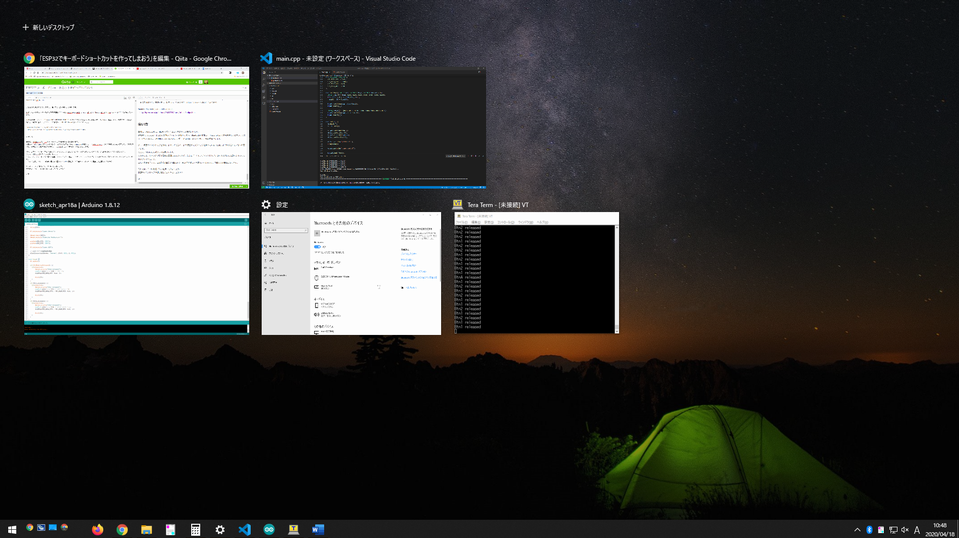Windowsには、キー配置を変更するためのツールがありますが、Altキーを押しながらF4キーや、Winキーを押しながらLキーなど、装飾キーとの組み合わせのキーボードショートカットが欲しい時があります。たいてい、ショートカットキーは、アプリをインストールして常駐させることが多いように思います。
それじゃあ、ESP32で作ってしまおうと。
・ESP32をBLEペリフェラルのHIDデバイスにする。
・ESP32に物理ボタンを接続して、押下を契機に、あらかじめ決めておいたキーの組み合わせを送信する。
今回は、ESP32としてM5StickCを採用し、物理ボタンとしてGroveで接続可能なデュアルボタンユニットを使います。
M5Stack用デュアルボタンユニット
https://www.switch-science.com/catalog/4048/
キーの割り当て
以下の3つのボタンを使います。
| IO | 割り当てキー |
|---|---|
| G32 | Win+Ctrl+→(仮想ディスクトップ切り替え+) |
| G33 | Win+Ctrl+←(仮想ディスクトップ切り替えー) |
| ボタンA | Win+TAB(タスクビュー表示) |
要は、仮想ディスクトップの切り替えです。
Arduinoコーディング
ソースコードはこんな感じです。あとで、カスタマイズ方法を示します。
//#include <Arduino.h>
# include <M5StickC.h>
# include <BLEDevice.h>
# include <BLEUtils.h>
# include <BLEServer.h>
# include "BLE2902.h"
# include "BLEHIDDevice.h"
# include "HIDTypes.h"
# include "HIDKeyboardTypes.h"
# define BLE_PASSKEY 123456
# define PIN_BTN1 32
# define PIN_BTN2 33
/*
* BLEデバイス処理
*/
BLEHIDDevice* hid;
BLECharacteristic* input;
BLECharacteristic* output;
bool connected = false;
class MyCallbacks : public BLEServerCallbacks {
void onConnect(BLEServer* pServer){
connected = true;
BLE2902* desc = (BLE2902*)input->getDescriptorByUUID(BLEUUID((uint16_t)0x2902));
desc->setNotifications(true);
M5.Lcd.fillScreen(BLACK);
M5.Lcd.setCursor(0, 0);
M5.Lcd.setTextSize(2);
M5.Lcd.println("Connected");
}
void onDisconnect(BLEServer* pServer){
connected = false;
BLE2902* desc = (BLE2902*)input->getDescriptorByUUID(BLEUUID((uint16_t)0x2902));
desc->setNotifications(false);
M5.Lcd.fillScreen(BLACK);
M5.Lcd.setCursor(0, 0);
M5.Lcd.setTextSize(2);
M5.Lcd.println("Disconnected");
}
};
// ペアリング処理用
class MySecurity : public BLESecurityCallbacks {
bool onConfirmPIN(uint32_t pin){
return false;
}
uint32_t onPassKeyRequest(){
Serial.println("ONPassKeyRequest");
return BLE_PASSKEY;
}
void onPassKeyNotify(uint32_t pass_key){
// ペアリング時のPINの表示
Serial.println("onPassKeyNotify number");
Serial.println(pass_key);
M5.Lcd.fillScreen(BLACK);
M5.Lcd.setCursor(0, 0);
M5.Lcd.setTextSize(2);
M5.Lcd.println("PIN");
M5.Lcd.println(pass_key);
}
bool onSecurityRequest(){
Serial.println("onSecurityRequest");
return true;
}
void onAuthenticationComplete(esp_ble_auth_cmpl_t cmpl){
Serial.println("onAuthenticationComplete");
if(cmpl.success){
// ペアリング完了
Serial.println("auth success");
}else{
// ペアリング失敗
Serial.println("auth failed");
}
}
};
// BLEデバイスの起動
void taskServer(void*){
BLEDevice::init("KeyShortcut");
BLEDevice::setEncryptionLevel(ESP_BLE_SEC_ENCRYPT_MITM);
BLEDevice::setSecurityCallbacks(new MySecurity());
BLEServer *pServer = BLEDevice::createServer();
pServer->setCallbacks(new MyCallbacks());
hid = new BLEHIDDevice(pServer);
input = hid->inputReport(1); // <-- input REPORTID from report map
output = hid->outputReport(1); // <-- output REPORTID from report map
std::string name = "Poruruba";
hid->manufacturer()->setValue(name);
hid->pnp(0x02, 0xe502, 0xa111, 0x0210);
hid->hidInfo(0x00,0x02);
BLESecurity *pSecurity = new BLESecurity();
pSecurity->setKeySize(16);
pSecurity->setAuthenticationMode(ESP_LE_AUTH_BOND);
pSecurity->setCapability(ESP_IO_CAP_OUT);
pSecurity->setInitEncryptionKey(ESP_BLE_ENC_KEY_MASK | ESP_BLE_ID_KEY_MASK);
uint32_t passkey = BLE_PASSKEY;
esp_ble_gap_set_security_param(ESP_BLE_SM_SET_STATIC_PASSKEY, &passkey, sizeof(uint32_t));
const uint8_t report[] = {
USAGE_PAGE(1), 0x01, // Generic Desktop Ctrls
USAGE(1), 0x06, // Keyboard
COLLECTION(1), 0x01, // Application
REPORT_ID(1), 0x01, // Report ID (1)
USAGE_PAGE(1), 0x07, // Kbrd/Keypad
USAGE_MINIMUM(1), 0xE0,
USAGE_MAXIMUM(1), 0xE7,
LOGICAL_MINIMUM(1), 0x00,
LOGICAL_MAXIMUM(1), 0x01,
REPORT_SIZE(1), 0x01, // 1 byte (Modifier)
REPORT_COUNT(1), 0x08,
HIDINPUT(1), 0x02, // Data,Var,Abs,No Wrap,Linear,Preferred State,No Null Position
REPORT_COUNT(1), 0x01, // 1 byte (Reserved)
REPORT_SIZE(1), 0x08,
HIDINPUT(1), 0x01, // Const,Array,Abs,No Wrap,Linear,Preferred State,No Null Position
REPORT_COUNT(1), 0x06, // 6 bytes (Keys)
REPORT_SIZE(1), 0x08,
LOGICAL_MINIMUM(1), 0x00,
LOGICAL_MAXIMUM(1), 0x65, // 101 keys
USAGE_MINIMUM(1), 0x00,
USAGE_MAXIMUM(1), 0x65,
HIDINPUT(1), 0x00, // Data,Array,Abs,No Wrap,Linear,Preferred State,No Null Position
REPORT_COUNT(1), 0x05, // 5 bits (Num lock, Caps lock, Scroll lock, Compose, Kana)
REPORT_SIZE(1), 0x01,
USAGE_PAGE(1), 0x08, // LEDs
USAGE_MINIMUM(1), 0x01, // Num Lock
USAGE_MAXIMUM(1), 0x05, // Kana
HIDOUTPUT(1), 0x02, // Data,Var,Abs,No Wrap,Linear,Preferred State,No Null Position,Non-volatile
REPORT_COUNT(1), 0x01, // 3 bits (Padding)
REPORT_SIZE(1), 0x03,
HIDOUTPUT(1), 0x01, // Const,Array,Abs,No Wrap,Linear,Preferred State,No Null Position,Non-volatile
END_COLLECTION(0)
};
hid->reportMap((uint8_t*)report, sizeof(report));
hid->startServices();
BLEAdvertising *pAdvertising = pServer->getAdvertising();
pAdvertising->setAppearance(HID_KEYBOARD);
pAdvertising->addServiceUUID(hid->hidService()->getUUID());
pAdvertising->start();
hid->setBatteryLevel(7);
// Serial.println("Advertising started!");
delay(portMAX_DELAY);
};
bool Btn1_released(void){
static int prev = 0;
int val = digitalRead(PIN_BTN1);
if( prev != val ){
prev = val;
return (val == 0);
}
return false;
}
bool Btn2_released(void){
static int prev = 0;
int val = digitalRead(PIN_BTN2);
if( prev != val ){
prev = val;
return (val == 0);
}
return false;
}
enum KEY_MODIFIER_MASK {
KEY_MASK_CTRL = 0x01,
KEY_MASK_SHIFT = 0x02,
KEY_MASK_ALT = 0x04,
KEY_MASK_WIN = 0x08
};
void sendKeys(uint8_t mod, uint8_t *keys, uint8_t num_key = 1){
uint8_t msg[] = {mod, 0x00, 0x00, 0x00, 0x00, 0x00, 0x00, 0x00};
for( int i = 0 ; i < num_key ; i++ )
msg[2 + i] = keys[i];
input->setValue(msg, sizeof(msg));
input->notify();
uint8_t msg1[] = {0x00, 0x00, 0x00, 0x00, 0x00, 0x00, 0x00, 0x00};
input->setValue(msg1, sizeof(msg1));
input->notify();
}
void setup() {
M5.begin();
M5.IMU.Init();
M5.Axp.ScreenBreath(9);
M5.Lcd.setRotation(3);
M5.Lcd.fillScreen(BLACK);
M5.Lcd.setTextSize(2);
M5.Lcd.println("[M5StickC]");
delay(1000);
M5.Lcd.println("start Serial");
Serial.begin(9600);
Serial.println("Starting KeyShortcut!");
pinMode(PIN_BTN1, INPUT);
pinMode(PIN_BTN2, INPUT);
M5.Lcd.println("start BLE");
// BLEデバイスの起動処理の開始
xTaskCreate(taskServer, "server", 20000, NULL, 5, NULL);
}
void loop() {
M5.update();
if( M5.BtnA.wasReleased() ){
if(connected){
Serial.println("BtnA released");
uint8_t keys[] = { 0x2B /* TAB */};
sendKeys(KEY_MASK_WIN, keys, 1);
delay(20);
}
}
if( Btn1_released() ){
if(connected){
Serial.println("Btn1 released");
uint8_t keys[] = { 0x50 /* LEFT Arrow */};
sendKeys(KEY_MASK_CTRL | KEY_MASK_WIN, keys, 1);
delay(20);
}
}
if( Btn2_released() ){
if(connected){
Serial.println("Btn2 released");
uint8_t keys[] = { 0x4F /* RIGHT Arrow */,};
sendKeys(KEY_MASK_CTRL | KEY_MASK_WIN, keys, 1);
delay(20);
}
}
}
カスタマイズ
WindowsからESP32を検索するときに表示される名前を変更する場合には、以下を変更してください。
BLEDevice::init("KeyShortcut");
Windowsに本ESP32をHIDとして登録する際に、PIN入力が必要なようにしています。
その時のPINを「123456」固定にしています。もし変える場合には、以下の部分を変更してください。
# define BLE_PASSKEY 123456
また、固定ではなく、毎回ランダムに変える場合には、以下の部分をコメントアウトしてください。ランダムPINは、M5StickCのLCDに表示されるようにしています。
uint32_t passkey = BLE_PASSKEY;
esp_ble_gap_set_security_param(ESP_BLE_SM_SET_STATIC_PASSKEY, &passkey, sizeof(uint32_t));
物理ボタンのスイッチが接続されたポート番号を変える場合には、以下を変更してください。
# define PIN_BTN1 32
# define PIN_BTN2 33
2つのボタンを想定していますが、増やすのはたやすいかと思います。
BLEでショートカットキーを送る処理は関数 void sendKeys(uint8_t mod, uint8_t *keys, uint8_t num_key = 1) で実装しています。
modに装飾キーとして enum KEY_MODIFIER_MASK をORでつなげて指定します。実際のキーは、keysに指定します。複数のキーを指定可能です。以下のページを参考に、USB HID Usageの列のID になります。
Japanese Keyboard (layout and scancode)
http://hp.vector.co.jp/authors/VA003720/lpproj/others/kbdjpn.htm
使い方
最初に、WindowsPCに、BLEキーボードとして登録する必要があります。
通常通り、「Bluetoothまたはその他のデバイスを追加する」 から、Bluetoothを検索します。「KeyShortcut」が発見されると思いますので、それを選択し、途中PIN入力を求められますが、「123456」と入力すれば、登録が完了します。
次に、仮想ディスクトップを作成します。おそらく、まだ仮想ディスクトップを使っていない方が多いと思いますので、まだ作成されていない場合は、M5StickCのボタンAを押下します。
そうすると、ウィンドウ切り替えの画面になるのですが、左上に「+新しいディスクトップ」というのがあると思いますのでそれをクリックします。
これで準備完了です。
それでは、2つの物理ボタンを押してみましょう。
仮想ディスクトップが切り替わりましたでしょうか?
参考情報
以下を参考にさせていただきました。
T-vK/ESP32-BLE-Keyboard
M5Stick-Cでパスワード記憶装置 兼 自動入力装置を作る
こちらが続編です。
ESP32でキーボーショートカットを作ってしまおう:改良版
以上

